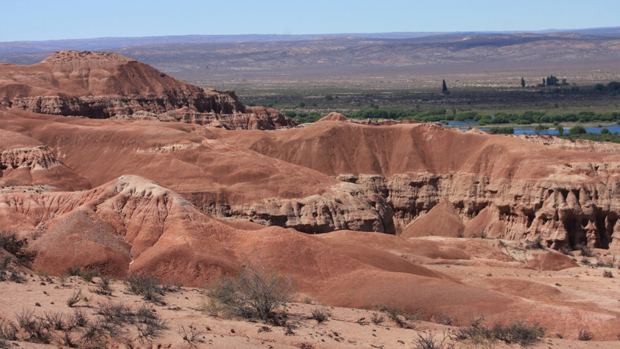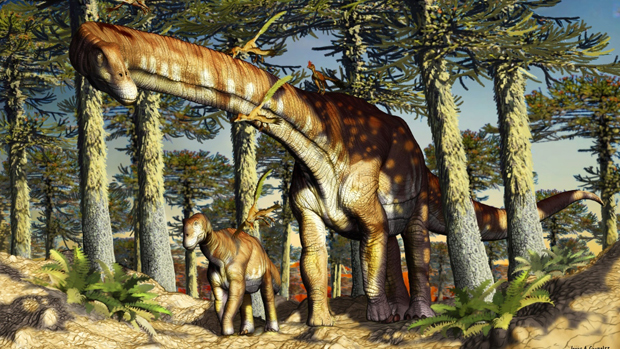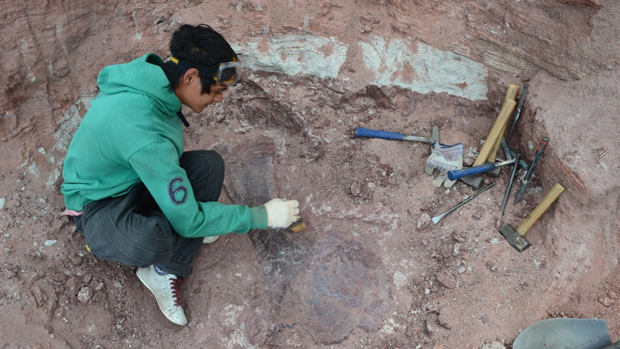Scientists have identified a new species of titanosaur from fragmentary fossil remains found in northern Patagonia (Argentina). Readers of Everything Dinosaur’s blog will know that there have been many amazing titanosaur fossil discoveries from Argentina featured on this site. Some of the largest dinosaurs known to science have been described from fossil material found in Patagonia, giants such Argentinosaurus, Patagotitan and Dreadnoughtus as well as slightly smaller ones, for example Sarmientosaurus (S. musacchioi)* with its beautifully preserved skull and the recently described Punatitan and Bravasaurus**.
However, the new species named Ninjatitan zapatai, is perhaps much more significant when it comes to the Titanosauria clade. The fossils from this titanosaur come from the Lower Cretaceous Bajada Colorada Formation located in Neuquén Province. Ninjatitan roamed Argentina around 140 million years ago, as such it could be the earliest known titanosaur sauropod, further strengthening the theory that these types of sauropod originated from South America.
A Life Reconstruction of Ninjatitan zapatai
Picture Credit: Jorge A. González courtesy of Fundación Azara.
Known from Fragmentary Remains
In 2014, Jonatan Aroca, a technician at the Ernesto Bachmann Municipal Museum, was exploring a rocky outcrop close to the Limay River between the towns of Picún Leufú and Piedra del Águila (Neuquén Province), when he spotted a large fossil bone eroding out of the sediments. This fossil proved to be the scapula (shoulder blade) and subsequent excavations revealed two dorsal vertebrae, a fibula, part of the femur and a tail bone. After the materials had been extracted and technically prepared and cleaned in the laboratory of the Chocón Museum, it was determined that this was a new species of sauropod titanosaur.
The Scapula (Shoulder Blade) is Excavated
Picture Credit: Jorge A. González courtesy of Fundación Azara.
The Origin of the Titanosauria
In recent years, several studies have postulated that the origin of the Titanosauria clade would have been in the early Cretaceous (about 140 million years ago) and somewhere in South America. However, until now, these hypotheses were not clearly supported by fossil evidence, but were the results of theoretical studies with statistical models.
Lead author of the scientific paper, Pablo Gallina, a CONICET (Consejo Nacional de Investigaciones Científicas y Técnicas), palaeontologist from the Palaeontology Area of the Azara Foundation and Maimonides University commented:
“This finding allows us to reinforce the idea that titanosaurs appeared in South America. It was thought that they might have first appeared there, but there was no real evidence, with fossils, to prove it. This finding gives more support to this theory.”
The Stunning Landscape of the Limay River

Picture Credit: Jorge A. González courtesy of Fundación Azara.
Everything Dinosaur acknowledges the assistance of a media release from CONICET in the compilation of this article.
At an estimated 20 metres in length Ninjatitan may not be the largest titanosaur from Argentina, but because of its age, it might just prove to be one of the most important South American titanosaur discoveries ever made.
Read our article about Sarmientosaurus* here: A New Late Cretaceous Titanosaur from Patagonia – Sarmientosaurus.
For our recent article on the titanosaurs Punatitan and Bravasaurus** click here: Two New South American Titanosaurs.
The scientific paper: “The Earliest Known Titanosaur Sauropod Dinosaur” by Pablo Ariel Gallina, Juan Ignacio Canale and José Luis Carballido published in Ameghiniana.








Leave A Comment